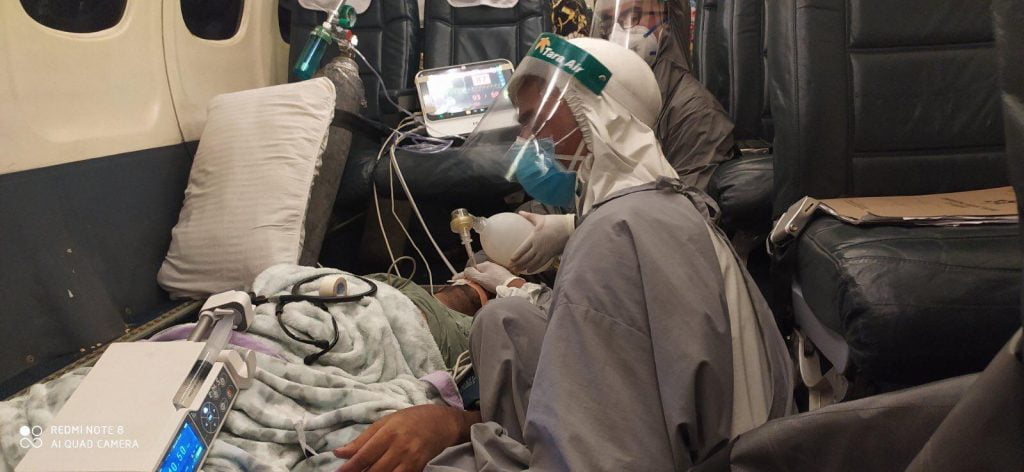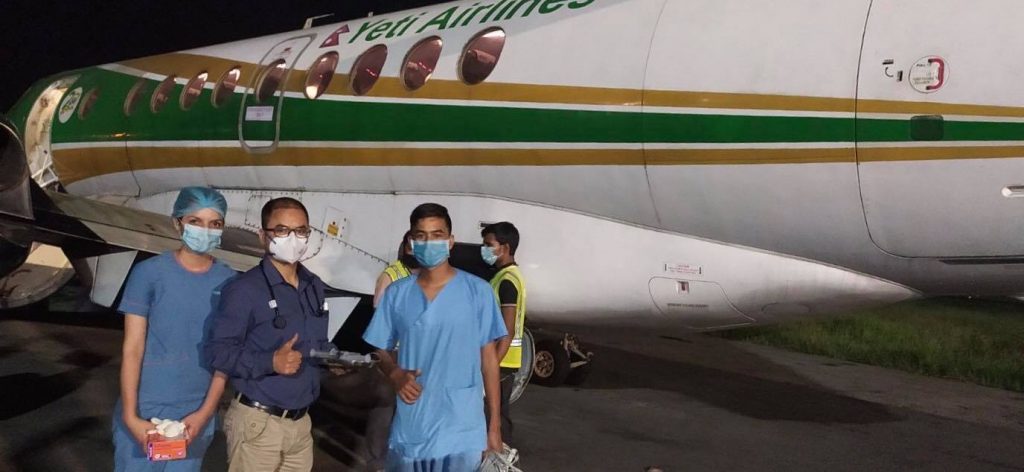
This was the very first time in the history of prehospital care in Nepal where a patient was intubated inside a fixed-wing aircraft. (Photos provided by the author.)
The call was received by our EMS team at the Hospital for Advanced Medicine & Surgery (HAMS) at 7:30 p.m. on July 26, 2020, for an air evacuation via a chartered flight on a Yeti Airlines Jet Stream.
Pilot in command: Capt. P.L. Thakali.
Medics in command: Dr .Ram Krishna Budhathoki.
Paramedic: Bali Jung Shahi.
Nurse: Sudiksha Mainali.
The mission was to bring a 47-year-old male patient from Biratnagar (An aerial distance of 231 kilometers) to HAMS Hospital in Kathmandu, Nepal.
The patient had a fever for one week, which resolved with antibiotics, along with a generalized body ache, nausea and a decreased appetite for the last three days. The Patient received two pints of IV fluid at home a day earlier for his decreased appetite and body weakness after which the patient started to complaint of chest pain, difficulty breathing and drowsiness. The patient was rushed to the local hospital at 4 a.m.
Previous: Essentials of BiPAP
An aortic aneurysm was repaired a year earlier with valve graft (Modified Bentall Procedure) and a history of DCM improved with medication that the patient was currently under (Tab Metoprolol 50MG and Tab Warfarin 5 MG).
As per the information given by one of the staff of that hospital, the patient was diagnosed as sepsis that was likely due to pneumonia with AKI(Acute kidney injury). The patient was not in respiratory distress and was currently under a low-dose inotropic support which occasionally required oxygen therapy.
Reviewing the history and status of the patient, it was thought that patient could be transferred, hence the EMS team was activated and reached to airport at 8:30 p.m. with full backup equipment, such as a patient monitor, portable oxygen, syringe pump, emergency drugs with intubation sets, and a patient carrying bag.
At 8:45 p.m., a chartered aircraft with a few seats taken off lifted from Kathmandu and landed at Biratnagar Airport at 9:30 p.m. On receiving patient inside the ambulance, there was no oxygen and inotropes support. The patient’s GCS was E3V3M5 ( 11/15), on attaching the monitor patient, the pulse rate was 130 bpm, RR 44/min , Spo2 (82-83% @ RA), BP 90/40 mmHg. Two 20 gauze IV cannulas were in the bilateral brachial vein and a Foley catheter was in situ.
Oxygen was immediately given via nasal, prong at 4 liters/min, and inotropes support was started with Noradrenaline at 2.5ml/hr (4mg Noradrenaline + 46 ml of NS in 50 ml syringe ). After that the patient’s Spo2 reached 85-86%. The nasal prong was switched to nasal mask with 6 liters/min O2 and Spo2 reached to 88 -90%, BP 100/60 mmHg with inotropes support. RR remained at 40/min, while the patient’s pulse was still 130 bpm .
We thought of intubating the patient onsite near the runway but due to poor lighting, extremely hot weather and the providers’ PPE, we thought it would be difficult. Instead, we shifted the patient inside the plane. Until then, the patient was stable, except persistent tachycardic and tachypnea. The patient was also a bit restless.
The plane took off from runway at 10:15 p.m. After 5 to 10 minutes in the air, the patient’s condition started to deteriorate. His pulse rate became 150-160 bpm , RR 60-66 /min and Spo2 gradually started to fall to 70%, and BP was 90/60 mmHg .
Looking at this status of the patient, we had two options:
- Conduct an emergency landing at Biratnagar Airport
- Conduct an emergency intubation in the air
The pilot was asked to do emergency landing, but we were told the flight was halfway to Kathmandu. So the bold decision was taken to intubate the patient onboard.
Pre-medication used:
- Inj Pantop 40mg iv stat
- Inj Ondem 4mg iv stat
- Inj Fentanyl 100 mcg iv stat
- Inj Midazolam 5mg iv stat
Induction agent used:
- Inj Ketamine 100mg iv stat
Paralytic agent used:
- Inj Vecuronium 4mg iv stat
Despite unfavorable circumstances, we were successful in intubating the patient with 7.5 F ET tube, fixed at 22 cm, after conforming to equal air entry over bilateral chest. Ambu-bagging was also started.
Gradually, the patient’s saturation increased to 88=90% via Ambu-bagging and 96% via Bain-circuit. The patient’s heart rate settled to 120 bpm and BP dropped to 80/44 mmHg, which later increased to 110/ 80 mmHg by increasing the noradrenaline dose to 10ml/hr gradually.
We faced several challenges intubating the patient inside the aircraft, including:
- Lack of adequate space
- Lack of proper lighting
- Hot weather inside the aircraft
- Wearing full PPE that caused face shields to fog up
- No proper height adjustment of the patient, coupled with doing intubation on the floor
- No patient privacy as the patient’s visitor was nearby
- No proper stability of the aircraft due to bad weather outside.
At around 10:45 p.m., the plane landed at TIA Kathmandu where hospital ambulance with a paramedic crew on standby.
Another challenging part was shifting the patient from the aircraft to the ambulance with the endotracheal tube.
Finally, the patient was transferred to HAMS ER via ambulance in stable condition at 11:30 p.m. with no other adverse events during the transfer. On receiving the patient at HAMS ER, vitals were BP 120/80 mmHg, pulse rate 130 bpm, Spo2 96% via Bain circuit, and temperature was 99.5F. The case was handed over to the HAMS ICU.

All smiles behind their masks after the successful operation.
Seeing the overall scenario, it highlights the importance of prehospital care as an important bridge for safe patient transfer from onsite (hospital or home) to the hospital. If prehospital care was not available during transfer of this patient, the patient would have likely died.
Prehospital care is still in its infancy in Nepal. Few hospitals have a proper EMS/HEMS system. This mission was flown on a fixed-wing aircraft as flying helicopters at night is not common in the country.
Dr Sanjaya Karki, who is involved in the prehospital care in Nepal, believes it is the first time in Nepal that a patient was intubated while on a fixed-wing aircraft.
Dr Karki says, “Prehospital care is still crawling in Nepal .Very few hospitals in Nepal consists of hospital based prehospital care department (EMS/HEMS) including Grande International Hospital, Nepal Mediciti Hospital, HAMS Hospital and Dhulikhel Hospital .However, other hospitals are giving attention to provide such services in the upcoming days because of importance of prehospital care is being acknowledged .Moreover, Nepal is in desperate need of prehospital care due to increasing in number of RTAs as well as advanced medical facilities are centrally located and proper transportation is always a big issue here.”
The author wishes to acknowledge Bal Krishna Pandit from Air Dynasty (Nepal), Dr. Kamal Thapa and the ICU team from HAMS Hospital for their coordination in making the mission successful.
Hospital for Advanced Medicine and Surgery (HAMS)
Department of ER/Prehospital Care
Kathmandu, Nepal



Nice job in a difficult situation
Wow. Truly Amazing work done by the EMS team.
Wish you all more successful rescue in upcoming days.